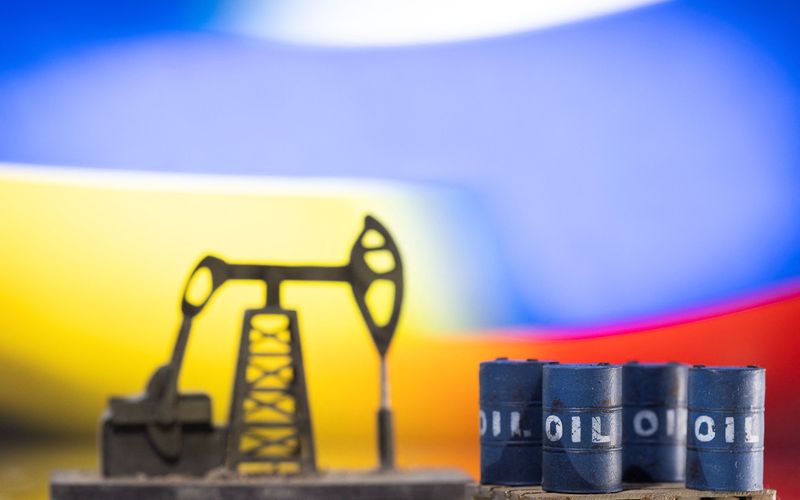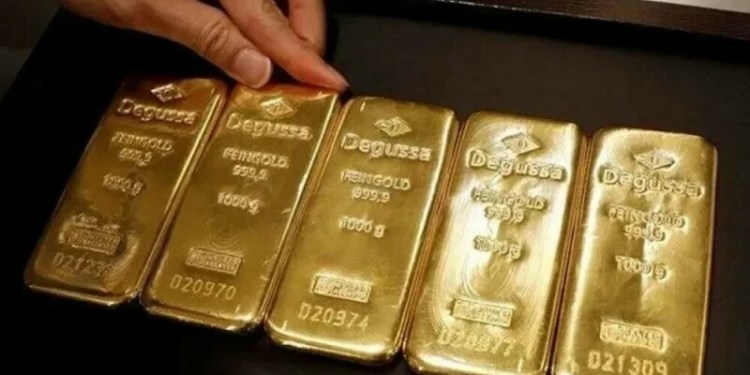
© Reuters. FILE PHOTO: Models of oil barrels and a pump jack are displayed in front of Ukrainian and Russian flag colors in this illustration taken, February 24, 2022. REUTERS/Dado Ruvic/Illustration
By Sonali Paul
MELBOURNE (Reuters) -Oil prices jumped on Monday on escalating sanctions against Russia over its invasion of Ukraine, which in turn led President Vladimir Putin to put his country’s nuclear deterrent on high alert.
Brent jumped back above $100 a barrel, initially surging more than $7, as the nuclear alert and bank payment constraints heightened fears that oil shipments from the world’s second-largest producer could be disrupted. Russia accounts for about 10% of global oil supply.
At 0643 GMT Brent crude futures were up $4.69, or 4.8%, at $102.62, after hitting a high of $105.07 a barrel in early trade. Last week the benchmark hit a more than seven-year high of $105.79 after Russia’s invasion of Ukraine began.
The April Brent contract expires on Monday. The May contract was up $5.28 at $99.40.
U.S. West Texas Intermediate (WTI) crude futures were up $5.34, or 5.8%, at $96.93 a barrel, after hitting a high of $99.10 early in the day. WTI climbed to as much as $100.54 last week.
“Moves by the U.S. and Europe to remove certain Russian banks from the SWIFT system have raised fears of a disruption to supply of some sort in the near term,” said ANZ commodity strategist Daniel Hynes.
“The risk to supply is the greatest we’ve seen for some time and it comes in a tight market,” he said.
Putin raised the stakes on Sunday, ordering Russia’s “deterrence forces” – which wield nuclear weapons – onto high alert, citing aggressive statements by NATO leaders and the range of economic sanctions imposed on Russia by the West. Russia calls its actions in Ukraine a “special operation.”
“President Putin’s decision to put Russian nuclear forces on high alert is a clear and worrying escalation that can only be supportive for oil prices,” said Stephen Brennock of oil broker PVM.
Gains were capped as it was still unclear exactly which banks were going to be affected by the SWIFT sanctions and whether energy payments would be exempt, said OANDA analyst Jeffrey Halley.
The market steadied on hopes for talks between Russia and Ukraine at a venue on the Belarusian border on Monday, the first negotiations since Russia invaded its neighbour last week.
“I’m absolutely sure if there’s any progress made in this meeting, we’re going to see a sharp reversal in markets – we’ll see stocks rise, the dollar rise and oil fall,” Halley said.
Amid the war in Ukraine, the Organization of the Petroleum Exporting Countries (OPEC), Russia and allies – together called OPEC+ – are due to meet on March 2. The group is expected to stick to plans to add 400,000 barrels per day (bpd) of supply in April.
Ahead of the meeting, OPEC+ revised down its forecast for the oil market surplus for 2022 by about 200,000 bpd to 1.1 million bpd, underscoring market tightness.
At the same time a separate report showed OPEC+ in January produced 972,000 bpd less than their agreed targets.
“The market being so tight with OPEC producers really struggling to raise output as well, means any issue with Russian supplies would be felt pretty significantly across the market,” ANZ’s Hynes said.
Source: Investing.com


























